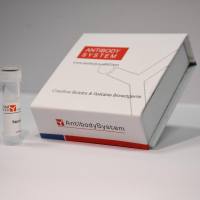Genome‐Wide Location Analysis by Pull Down of In Vivo Biotinylated Transcription Factors
互联网
- Abstract
- Table of Contents
- Materials
- Figures
- Literature Cited
Abstract
Recent development of methods for genome?wide identification of transcription factor binding sites by chromatin immunoprecipitation (ChIP) has led to novel insights into transcriptional regulation and greater understanding of the function of individual transcription factors. ChIP requires highly specific antibody against the transcriptional regulator of interest, and availability of suitable antibodies is a significant impediment to broader application of this approach. This limitation can be circumvented by tagging the transcriptional regulator of interest with a short bio epitope which is specifically biotinylated by the E. coli enzyme BirA. The biotinylated transcription factor can then be selectively pulled down on streptavidin beads under stringent conditions. This unit provides a detailed protocol for genome?wide location analysis of in vivo biotinylated transcription factors by streptavidin pull?down followed by high?throughput sequencing (bioChIP?seq). Curr. Protoc. Mol. Biol. 92:21.20.1?21.20.15. © 2010 by John Wiley & Sons, Inc.
Keywords: ChIP?seq; transcription factor; biotinylation; genome?wide location analysis
Table of Contents
- Introduction
- Strategic Planning
- Basic Protocol 1: Genome‐Wide Location Analysis of In Vivo Biotinylated Transcription Factors by Streptavidin Pull‐Down Followed by High‐Throughput Sequencing (bioChIP‐seq)
- Support Protocol 1: Optimization of Sonication Conditions for bioChIP‐seq
- Support Protocol 2: Conversion of bioChIP‐seq DNA to a Library for Sequencing on the Illumina Genome Analyzer 2
- Reagents and Solutions
- Commentary
- Literature Cited
- Figures
Materials
Basic Protocol 1: Genome‐Wide Location Analysis of In Vivo Biotinylated Transcription Factors by Streptavidin Pull‐Down Followed by High‐Throughput Sequencing (bioChIP‐seq)
Materials
Support Protocol 1: Optimization of Sonication Conditions for bioChIP‐seq
Materials
|
Figures
-
Figure 21.20.1 System for expression of biotinylated transcription factors. (A ) Two‐vector system for titratable expression of transcription factors with C‐terminal FLAG and bio peptides. BirA recognizes and biotinylates the bio sequence on the central lysine residue (asterisk). (B ) Titration of tagged transcription factor expression by adjusting the concentration of Dox. Tagged transcription factors are slightly larger than the corresponding endogenous protein due to the epitope tags. View Image -
Figure 21.20.2 Optimization of sonication conditions. A 2‐ml quantity of nuclear extract was sonicated for 5 or 8 min using a Misonix 4000 with the amplitude of 70, cycles 15 sec on and 1 min off. The plot on the right shows size versus intensity profile of sonicated chromatin. A sonication time of 8 min led to the desired size peak of ∼200 bp. View Image -
Figure 21.20.3 Gel size selection of fragmented chromatin and ChIP‐seq library. View Image
Videos
Literature Cited
| Beckett, D., Kovaleva, E., and Schatz, P.J. 1999. A minimal peptide substrate in biotin holoenzyme synthetase‐catalyzed biotinylation. Protein Sci. 8:921‐929. | |
| Blahnik, K.R., Dou, L., O'Geen, H., McPhillips, T., Xu, X., Cao, A.R., Iyengar, S., Nicolet, C.M., Ludascher, B., Korf, I., and Farnham, P.J. 2010. Sole‐Search: An integrated analysis program for peak detection and functional annotation using ChIP‐seq data. Nucleic Acids Res. 38:e13. | |
| de Boer, E., Rodriguez, P., Bonte, E., Krijgsveld, J., Katsantoni, E., Heck, A., Grosveld, F., and Strouboulis, J. 2003. Efficient biotinylation and single‐step purification of tagged transcription factors in mammalian cells and transgenic mice. Proc. Natl. Acad. Sci. U.S.A. 100:7480‐7485. | |
| Farnham, P.J. 2009. Insights from genomic profiling of transcription factors. Nat. Rev. Genet. 10:605‐616. | |
| Ji, H., Jiang, H., Ma, W., Johnson, D.S., Myers, R.M., and Wong, W.H. 2008. An integrated software system for analyzing ChIP‐chip and ChIP‐seq data. Nat. Biotechnol. 26:1293‐1300. | |
| Kim, J., Chu, J., Shen, X., Wang, J., and Orkin, S.H. 2008. An extended transcriptional network for pluripotency of embryonic stem cells. Cell 132:1049‐1061. | |
| Park, P.J. 2009. ChIP‐seq: Advantages and challenges of a maturing technology. Nat. Rev. Genet. 10:669‐680. | |
| Pepke, S., Wold, B., and Mortazavi, A. 2009. Computation for ChIP‐seq and RNA‐seq studies. Nat. Methods 6:S22‐S32. | |
| Key References | |
| de Boer et al., 2003. See above. | |
| Application of the bio epitope tag for one step purification of mammalian proteins. | |
| Blahnik et al., 2010. See above. | |
| Describes a bioinformatic tool for read alignment, peak calling, and peak annotation. | |
| Kim et al., 2008. See above. | |
| Application of in vivo transcription factor biotinylation to genome‐wide location analysis by bioChIP‐chip. | |
| Internet Resources | |
| http://chipseq.genomecenter.ucdavis.edu/cgi‐bin/chipseq.cgi | |
| Sole‐Search: Web‐based tool for read alignment, peak calling, and peak annotation. | |
| http://frodo.wi.mit.edu/primer3/ | |
| Primer3: Web‐based tool for designing PCR primers. |








